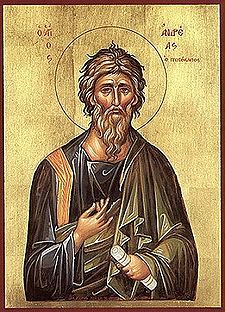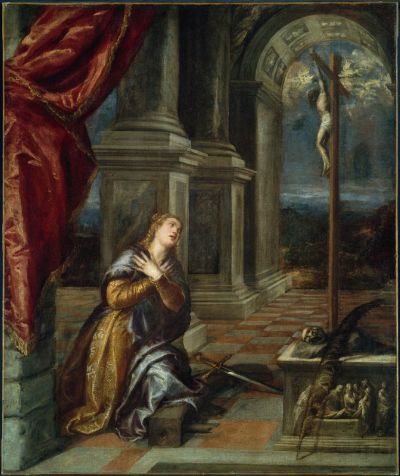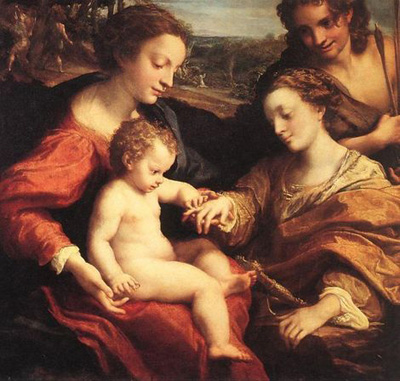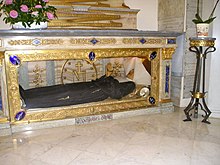Feastday: November 30
Patron of FishermanWe humbly entreat Thy majesty, O Lord, that as the blessed Apostle Andrew was once a teacher and ruler of Thy Church: so he may be a constant advocate for us before Thee. Through our Lord Jesus Christ, Thy Son, Who liveth and reigneth with Thee in the unity of the Holy Ghost, one God, world without end. Amen.
Saint Andrew Christmas Novena
to Obtain Favors
Hail and blessed be the hour and moment in which the Son of God was born of the most pure Virgin Mary, at midnight, in Bethlehem, in piercing cold. In that hour, vouchsafe, O my God! to hear my prayer and grant my desires (pray for your intentions here), through the merits of Our Saviour Jesus Christ, and of His Blessed Mother. Amen.
The Saint Andrew Christmas Novena is often called simply the "Christmas Novena" or the "Christmas Anticipation Prayer," because it is prayed 15 times every day from the Feast of Saint Andrew the Apostle (November 30) until Christmas. You can say the prayer all 15 times, all at once; or divide up the recitation as necessary.
Life of St. Andrew
According to New Testament scripture, St. Andrew, the Apostle, son of Jonah, or John, was born in Bethsaida of Galilee. Andrew, like his brother Simon Peter, was a fisherman. He became a disciple of the great St. John the Baptist, but when John pointed to Jesus and said, "Behold the Lamb of God!" Andrew understood that Jesus was greater. At once he left John to follow the Divine Master. Jesus knew that Andrew was walking behind him, and turning back, he asked, "what do you seek?" When Andrew answered that he would like to know where Jesus lived, Our Lord replied, "Come and see." Andrew had been only a little time with Jesus when he realized that this was truly the Messiah.
 |
| St Andrew the First Called Painting of the calling of St Peter and St. Andrew by Duccio di Buoninsegna |
From then on, he chose to follow Jesus. Andrew was thus the first disciple of Christ. Next, Andrew brought his brother Simon (St. Peter) to Jesus and Jesus received him, too, as His disciple. At first the two brothers continued to carry on their fishing trade and family affairs, but later, the Lord called them to stay with Him all the time. He promised to make them fishers of men, and this time, they left their nets for good. It is believed that after Our Lord ascended into Heaven, St. Andrew went to Greece to preach the gospel.
Saint Andrew was martyred by crucifixion at Patras in Achaea in Greece. Because St. Andrew deemed himself unworthy to be crucified on the same type of cross on which Christ had been crucified, he asked to be tied to a Crux decussata or an X shaped cross. The instrument of his martyrdom – the X shaped cross – has become the symbol of Andrew. The Apostle Andrew did not die right away but instead he was left to suffer for two days while he continued to preach the gospel of Jesus Christ until he finally died. He lived two days in that state of suffering, still preaching to the people who gathered around their beloved Apostle.
His relics consist of a small finger, the top of his cranium and pieces of the cross. These are kept in a shrine at the Church of St. Andrew in Patras.
Saint Andrew is the Patron Saint of Scotland, Russia and Greece. Scots celebrate Saint Andrew's Day around the world on the 30th of November. The flag of Scotland is the Cross of St. Andrew.
Saint Andrew is the Patron Saint of Scotland, Russia and Greece. Scots celebrate Saint Andrew's Day around the world on the 30th of November. The flag of Scotland is the Cross of St. Andrew.
The feast of St. Andrew the Apostle (30 November) is used as a marking point for the beginning of Advent, the period of expectant waiting and preparation for the celebration of the Nativity of Jesus, which begins with the Sunday nearest to the feast day and embracing four Sundays. The first Sunday may be as early as 27 November, and then Advent has twenty-eight days, or as late as 3 December, giving the season only twenty-one days. With Advent the ecclesiastical year begins in the Western churches.
In the traditional liturgical books of the Catholic Church, the feast of St. Andrew is the first feast day in the Proper of Saints. It is also the first day to begin the Christmas Novena (above).
PRAYERS TO ST. ANDREW
REFERENCES
http://www.newadvent.org/cathen/01471a.htm
http://en.wikipedia.org/wiki/Saint_Andrew
http://www.catholic.org/saints/saint.php?saint_id=109
http://iconsandimagery.blogspot.com/2009_11_01_archive.html
http://www.saintandrew.us/
http://en.wikipedia.org/wiki/St_Andrew%27s_Day
http://www.nas.gov.uk/about/051124.asp
http://www.gutenberg.org/catalog/world/readfile?fk_files=1499041&pageno=4
http://www.youtube.com/watch?v=lyQTfIHPrK0&feature=relmfu
http://www.aug.edu/augusta/iconography/goldenLegend/andrew.htm
http://www.saintandrew.us/st-andrew-prayer.html

| Saint Andrew the Apostle | |
|---|---|
Saint Andrew, by José de Ribera | |
| Apostle, First-called | |
| Born | early 1st century |
| Died | mid- to late 1st century AD |
| Honored in | All Christianity |
| Majorshrine | Church of St Andreas at Patras, with his relics |
| Feast | November 30 |
| Attributes | Old man with long (in the East often untidy) white hair and beard, holding the Gospel Book orscroll, sometimes leaning on asaltire |
| Patronage | Scotland, Ukraine, Russia, Sicily,Greece, Cyprus, Romania,Diocese of Parañaque, Philippines,Amalfi, Luqa (Malta) and Prussia;Diocese of Victoria fishermen, fishmongers, rope-makers, golfers and performers |
Saint Andrew's Day | |
|---|---|
St Andrew | |
Observed by | Roman Catholic Church (traditional holy day of precept) Patronal feast of Scotland |
Type | Bank holiday in Scotland. |
Date | 30 November |
Celebrations | Bank holiday |
PRAYERS TO ST. ANDREW
http://www.catholic-saints.info/catholic-saints-prayers/prayer-to-st-andrew.htm
Prayer to St. Andrew O Glorious St. Andrew, you were the first to recognize and follow the Lamb of God. With your friend St. John you remained with Jesus for that first day, for your entire life, and now throughout eternity. As you led your brother St. Peter to Christ and many others after him, draw us also to him. Teach us to lead others to Christ solely out of love for him and dedication in his service. Help us to learn the lesson of the Cross and to carry our daily crosses without complaint so that they may carry us to Jesus. <><><><><><><><> |
REFERENCES
http://www.newadvent.org/cathen/01471a.htm
http://en.wikipedia.org/wiki/Saint_Andrew
http://www.catholic.org/saints/saint.php?saint_id=109
http://iconsandimagery.blogspot.com/2009_11_01_archive.html
http://www.saintandrew.us/
http://en.wikipedia.org/wiki/St_Andrew%27s_Day
http://www.nas.gov.uk/about/051124.asp
http://www.gutenberg.org/catalog/world/readfile?fk_files=1499041&pageno=4
http://www.youtube.com/watch?v=lyQTfIHPrK0&feature=relmfu
http://www.aug.edu/augusta/iconography/goldenLegend/andrew.htm
http://www.saintandrew.us/st-andrew-prayer.html























